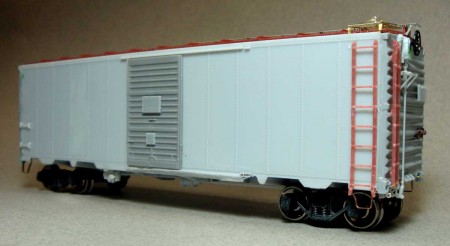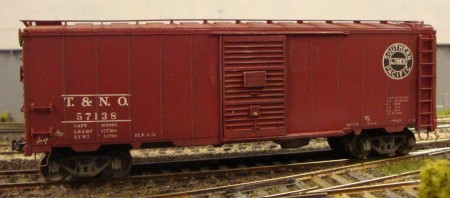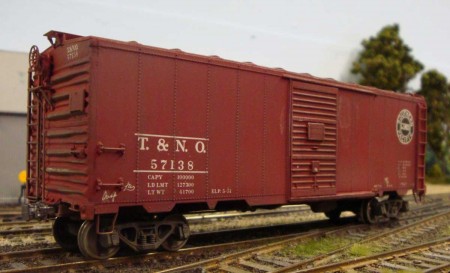Clark Propst has offered some different ideas on prototype freight car modeling. Here’s what it looks like from his point of view.
The way I go about choosing my freight car fleet could be best described as “Backwards modeling”. What is “Backwards modeling”? It starts with a Prototype designed layout with representatives of actual customers in correct locations. These customers are researched to find the type of materials they shipped and/or received. Real railroad documents are combed through to find freight cars that carried those loads. Once a list of likely candidates is compiled, the search is on for information about the freight cars and how they be modeled. When the freight car model is completed it will then bring or take a specific commodity from a customer.

I’ll use Northwestern Distributing as an example. Northwestern was a feed mill in Mason City, Iowa. The mill was served by the Minneapolis & St Louis Railway, which I just happen to model.

In the mid- 50s, Northwestern shipped almost 450 cars of “Mor-Gain” feeds a year. Of course, there would be a kaleidoscope of ingredients bought in to mix the feeds. Let’s take a look at modeling one of those cars.

I have a train list with associated consist billing for M&StL westbound freight #95. The fourth car from the bottom on the list is TNO 57138 with a load of potash bound for Mason City, station number 1156, abbreviated to 156. If we look at the consist page (the list on the right, above), we see the car is billed to Northwestern Distributing. Let’s build it! Uh, but what is it? I could spend time thrashing around or I could just contact Tony Thompson. Tony tells me that TNO 57138 is a class B-50-26 from series 57000-57199 and gives me advice on how to model the car.

To replicate a B-50-26, I used an undecorated Intermountain 12 panel box car. I replaced the roof with a more accurate version from Red Caboose, to which I added a Plano running board and the Plano brake step. Doors are from Southwest Scale Models. Ladders are 8 rung versions from Des Plaines Hobbies. The brake wheel is a Kadee product, while the trucks are Kato A-3 ride control with Intermountain wheelsets. I used Archer rivets on the sill tabs. Lastly, the most difficult to obtain pieces to the puzzle were the conversion parts from Speedwitch Media. I used their resin ends, placard boards, door tracks/stops, and decals.

Now I have a prototype car delivering a prototype load to a prototype customer on a prototype layout. How anal is that?
Clark Propst
We thank Clark Propst for sharing his insightful backwards modeling technique. Questions and comments can be posted below. Please follow the instructions so your comment can be posted. All comments are reviewed and approved before they appear. To subscribe to this blog, enter your info for a comment and check the last box to notify of new posts by email.

Hi Clark,
How anal is that? Better you should ask, “How satisfying is that?”
Thank you for documenting and sharing your insight into the joy of prototype model railroading. I found it simply inspiring!
My compliments and best regards,
Jim Dufour
The thing I like about our hobby is that there is always something new I can learn.
Thank you Eric for you Blog, it’s always fun to read. Thank you Clark for your article on your reverse modeling technique. Clark’s technique is quite a contrast from the way most modeler’s aquire freight cars.
I’m using the same approach based upon a conductor’s book from 1934. How did you come up with a decal that had the exact number you needed? Is that an ALPs decal, custom ordered, or did you just get that lucky with a commercial set?
Nice looking car. Thanks for posting your backwards modeling. And great job on your building of the Northwestern Distributing as well. Love those awnings.
I am not a modeler because I simply don’t have the skills. I do however have a keen interest in the M&ST.L at Mason City Iowa. My grandfathers house backed up on the
M&ST.L at 509 North Georgia directly behind the Coal Chute. I spent a lot of time as a boy at the Roundhouse. Bill Collins was the Roundhouse foreman. There was usually
a spare 600 hundred in the house, and engines 65 and 66 were housed there at night.
This was in the late 30’s and the wars years. I hope this if some interest to others!
I’ll add to Clark’s comments about the difficulty of obtaining the Speedwitch parts. I am doing some rework on these parts and will reissue the B-50-25 parts and I’ll add the B-50-26 parts and decals, as well, so that both can be modeled. I’ll have these by the meeting in Collinsville (St. Louis) this summer, if not sooner.
Ted Culotta
I made an error on the load type. It should be Phosphate not Potash, sorry.
A good read it just shows how many aspects there are to this hobby of ours.
Paul Doggett